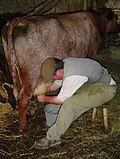Especialidades JA/Ordeñar una vaca
Históricamente, el ordeño y el procesamiento tuvieron lugar juntos en el espacio y el tiempo: en una granja lechera.
La gente ordeñaba los animales a mano; en las granjas donde solamente se mantienen cantidades pequeñas, se puede practicar el ordeño manual. El ordeño manual se logra agarrando las tetinas (a menudo pronunciadas 'tetas') en la mano y extrayendo leche apretando los dedos, progresivamente, desde el extremo de la ubre hasta la punta o apretando la tetina entre el pulgar y el dedo índice y luego moviendo la mano hacia abajo desde la ubre hacia el final de la tetina. Esto se repite, usando ambas manos para la velocidad. Ambos métodos dan como resultado que la leche que quedó atrapada en el conducto de leche se vierta por el extremo en un balde que se apoya entre las rodillas (o descansa en el suelo) del ordeñador, que generalmente se sienta en un taburete bajo.
Traditionally the cow, or cows, would stand in the field or paddock while being milked. Young stock, heifers, would have to be trained to remain still to be milked. In many countries the cows were tethered to a post and milked. The problem with this method is that it relies on quiet, tractable beasts, because the hind end of the cow is not restrained. In cold countries where cows are kept in barns, at least for the winter if not throughout the year, they are still tethered only by the neck or head, particularly where they are kept in small numbers.

